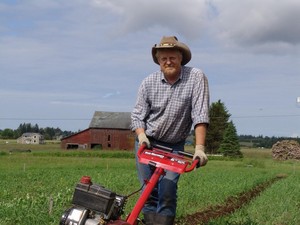22 Feb Sun 2009
Frozen Credit
On February 20th, Toni and I went to a discussion of the New Recovery Plan by a local US Congressman. During the question period, I asked him about the effect of frozen credit on spring planting. My point was that mainstream US agriculture depends on credit to plant and grow the crops. If there is no credit from the banks, there will be reduced acreage planted and consumers will wake up in July and August and wonder where the wheat and corn is. The Congressman acknowledged my worry and said that many national leaders see this also. However, there was no mention of what is being done to unfreeze credit and there was NO URGENCY expressed. I suddenly realized why some of the more perspicacious of the local Dems don't like this person. I don't see anything being done in the short time frame we have left, so is there some government intervention behind the scenes to actually fix this problem in the 2-3 months we have left before planting? Since the government colluded with corporations and banks to get us into this mess, it doesn't seem likely they are working to fix it and that the impasse we see in front of us is all there is.
Let's assume for a moment that a significant decrease in spring planting is inevitable this spring. By significant, I mean a greater than 5% decrease in acres planted. Some might say this is not a significant percentage, but I suggest a simple thought exercise in demographics - imagine a 5% increase in unemployment in the next 2 months. As for a 5% significance level, that is just a common metric from statistics and I am using it as a threshold of significance. (In other words, let's start with a small effect that would impact our lives in a significant manner.)
So, with a significant decrease in corn, soy, and wheat acreage planted in the Midwest, prices for livestock feed rise, simply because most grain in this country is fed to cattle, hogs and poultry. The rise in feed prices causes a rise in the price of meat, which in turn causes meat consumption to decrease. An oversupplied market will then find a level at which consumers can afford to buy meat, but this will not likely be cost effective for the farmers. Then farmers will cull their herds and flocks. This then causes an oversupply of meat, which depresses prices. By now, it is Christmas 2009 and there is a plentiful amount of meat on store shelves. It is even within the realm of possibility to buy beef for Christmas this year for 50 cents a pound (!). Good times will be back for the consumer - but only for a few months. Once the relative supply of beef (ongoing production and an infinite resource) becomes the absolute supply of beef (culling herds - a finite resource), there will be very little calving, farrowing and hatching to make up the lost reserves. Then there will be a shortage of meat on top of the shortage of grain. If the credit freeze of spring 2009 is still on and becomes the credit freeze of spring 2010, there will be even less planting than the previous year. The shortage of grain in the summer/fall of 2010 then becomes a serious matter.
An alternative hypothesis is that there is no significant shortfall in credit available to farmers to plant. Then we are simply faced with "business as usual," which is still problematic. Prices for wheat continue to fall below the cost of production, so it may be prudent for farmers to plant less anyway. So there will be stresses and strains and the inflationary pressures in the current economy may push food prices up anyway. If the meat producers do not cull their herds in a significant manner, there will be plenty of backup in the system to adapt quickly to a fair price for the farmer. However, this still means prices for meat will probably rise this year. I also see prices for vegetables and fruit rising as well, but that is because of a rise in transport costs.
Which hypothesis will play out depends on the credit market. Thus, modern US agriculture is dependent on bankers at the tiller, bankers who are besieged from all sides and flailing around on a ship in a governmentally-produced fog of regulations and policies, balancing on a rolling deck while cannons broken from their moorings are rolling back and forth and even firing on a randomly selected time-delay. It is not a pretty sight.
The bottom line is that agriculture is subject to a time lag in supply and demand. Without thinking ahead to next year, we lose out. You cannot just go to the marketplace and buy more steel to make a widget. You have to get the seeds in the ground at a certain time of the year. Also note that the US is still a net exporter of food, so if we screw up in the next 2-3 months, the whole world will suffer.

